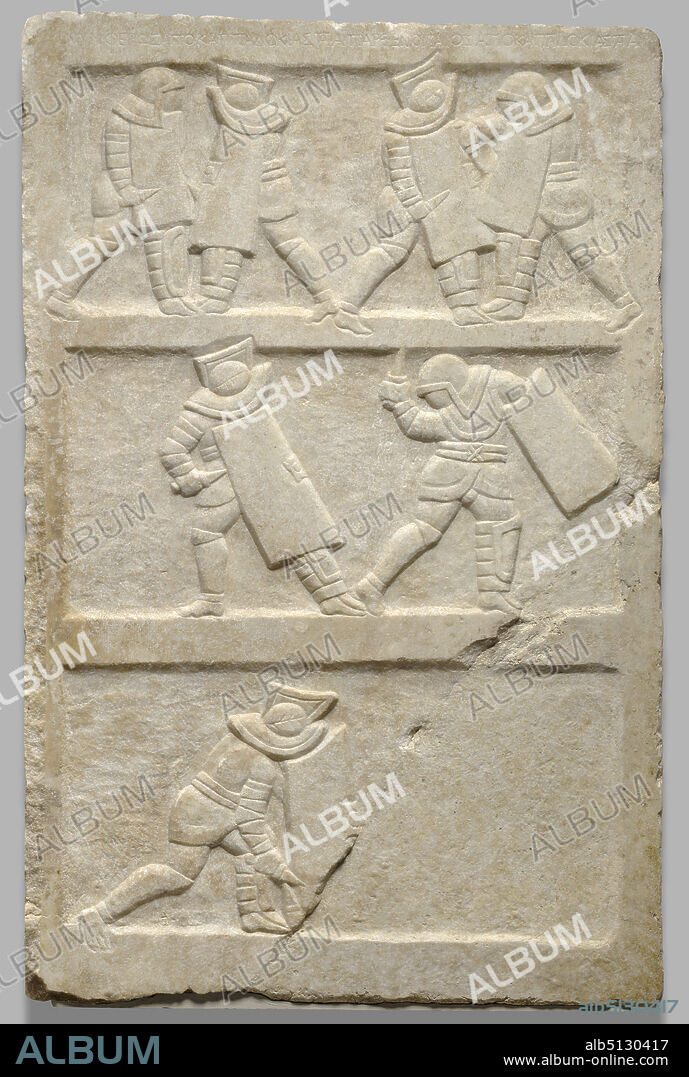alb5130417
Relief with Gladiators, ca. 2nd century A.D., Marble, 122.6 × 80.2 × 6.2 cm (48 1/4 × 31 9/16 × 2 7/16 in.), Gladiatorial games originated as funerary rites in which the deceased was celebrated through physical competitions. For this reason, relief depictions of gladiatorial combat were sometimes used as grave markersprobably not for gladiators themselves, but for those whose lives such games may have commemorated. The games were particularly popular during the Roman Empire; in fact, most of the known funerary depictions of gladiators are Imperial in date. As government sponsorship grew in the Empire, the games took on political overtones. By staging massive and elaborate series of combats that often lasted for months and involved the slaughter of scores of men and wild animals in arenas throughout the empire, the Romans culturally unified their territory and affirmed their power, both to create such dramatic spectacles, and over life and death themselves. , Roman, Roman, Sculpture.

|
Add to another lightbox |
|
Add to another lightbox |



Buy this image.
Select the use:

Caption:
Relief with Gladiators, ca. 2nd century A.D., Marble, 122.6 × 80.2 × 6.2 cm (48 1/4 × 31 9/16 × 2 7/16 in.), Gladiatorial games originated as funerary rites in which the deceased was celebrated through physical competitions. For this reason, relief depictions of gladiatorial combat were sometimes used as grave markersprobably not for gladiators themselves, but for those whose lives such games may have commemorated. The games were particularly popular during the Roman Empire; in fact, most of the known funerary depictions of gladiators are Imperial in date. As government sponsorship grew in the Empire, the games took on political overtones. By staging massive and elaborate series of combats that often lasted for months and involved the slaughter of scores of men and wild animals in arenas throughout the empire, the Romans culturally unified their territory and affirmed their power, both to create such dramatic spectacles, and over life and death themselves. , Roman, Roman, Sculpture
Credit:
Album / quintlox
Releases:
Model: No - Property: No
Rights questions?
Rights questions?
Image size:
3359 x 4992 px | 48.0 MB
Print size:
28.4 x 42.3 cm | 11.2 x 16.6 in (300 dpi)
Keywords:
AFFIRMED • AND • ARENAS • BAS-RELIEF • CA. 2ND CENTURY A. D. • CELEBRATED • COMBATS • COMMEMORATED. • CREATE • DATE. • DEATH THEMSELVES. • DECEASED • DRAMATIC SPECTACLES • ELABORATE SERIES • EMBOSSED • EMPIRE • EMPIRE, THE • FUNERARY DEPICTIONS • FUNERARY RITES • GAMES • GAMES, THE • GLADIATORIAL COMBAT • GLADIATORIAL GAMES ORIGINATED • GLADIATORS THEMSELVES • GLADIATORS • GOVERNMENT SPONSORSHIP GREW • GRAVE MARKERS • IMPERIAL • IN FACT • INVOLVED • LASTED • LIFE • LIVES • MALES • MAN MEN • MARBLE • MARBRE • MARMOL • MASSACRE • MEN • MONTHS • MUSIC: SCORE • PARTICULARLY POPULAR • PHYSICAL COMPETITIONS. • POLITICAL OVERTONES. • POWER • PRINTED MUSIC • RATIONALITY • REASON • RELIEF DEPICTIONS • RELIEF • RELIEFS • RELIEVE • ROMAN EMPIRE • ROMAN • ROMANO • ROMANS CULTURALLY UNIFIED, THE • SCORE (MUSIC) • SCORE • SCORES • SCULPTED • SCULPTING • SCULPTURE • SCULPTURE. • SCULPTURES • SCUPTURE • SHEET MUSIC • SLAUGHTER • SOMETIMES • STAGING MASSIVE • TERRITORY • THE • WILD ANIMALS
 Pinterest
Pinterest Twitter
Twitter Facebook
Facebook Copy link
Copy link Email
Email
